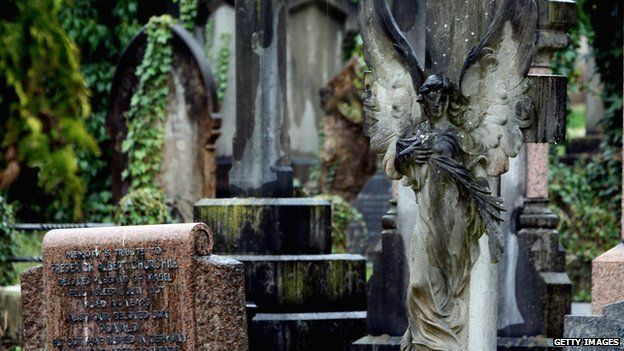The world is running out of burial space
- Published

There is a looming problem in many parts of the world over what to do with dead bodies, as pressure on burial space intensifies.
The industrial revolution, in the 18th and 19th Centuries, saw a mass migration from small villages and towns to cities.
Previously, most people had lived in rural locations and would be buried in the local church's graveyard.
But with a growing urban population, the authorities in Victorian Britain built large cemeteries, often on the outskirts of cities.
Those cemeteries are now largely full.
Institute of Cemetery and Crematorium Management chief executive Tim Morris says a crisis is looming, even though most British people choose cremation.
"Two London boroughs - Tower Hamlets and Hackney - have ceased providing a burial service," he says.
"Residents have to go to neighbouring boroughs."
Mr Morris says Britain's cities are feeling the strain first, but so are leafier parts of the country.
"Local authorities have to try to find land for new cemeteries, which is expensive, while still covering the maintenance costs of older cemeteries."
Recycle plots
Dr Julie Rugg, from York University's Cemetery Research Group, says burying a body far away from relatives can cause problems.
"There will be issues if people want to visit the grave frequently, but have to travel far.
"Then there's the issue of people being unable to be buried with other family members because there's no space - splitting up family graves."
A 2013 survey indicated nearly half of England's cemeteries could run out of space within the next 20 years.
One solution is to recycle plots by removing remains from older graves, burying them deeper in the same grave and then reusing the space on top for a new body.
Other countries in Europe, such as Germany, simply reuse the same grave space after several years.
Families in Spain and Greece, meanwhile, rent a "niche", an above-ground crypt where bodies lie for several years.
When they have decomposed, the bodies are moved to a communal burial ground, so the niche can be used again.
Venice's San Michele island cemetery is similarly oversubscribed, with bodies removed after they have decomposed.
And Israel has approved the creation of multi-storey underground burial tunnels, despite opposition from some Orthodox Jews.
In more crowded parts of the world, cremation is the norm, but even finding space for an urn can be a challenge.
In Hong Kong, thousands of families store ashes in sacks in funeral homes, while they wait years for a space in either public or private cemeteries.
And in Singapore, one private company stores 50,000 urns, which can be automatically retrieved with an electronic card.
In the second-most populous country in the world, India, the majority Hindu population scatter the ashes of the dead after cremation - but Muslims and Christians, who bury bodies, are running out of suitable land.
Others regions, such as the US state of Minnesota, are using resomation, dubbed "green cremation".
Mr Morris says: "Resomation is a process where the body is exposed to alkaline, which breaks it down to ash and liquid.
"It's currently not a lawful option in Britain - but Scotland is consulting on the idea."
Resomation
- Uses a chemical process called alkaline hydrolysis
- The body is placed in a bag within a metal frame and loaded into a machine filled with a mixture of water and the highly alkaline chemical potassium hydroxide
- The contents are heated to up to 180C but at high pressure to prevent boiling
- After about three hours, the body is effectively broken down into its chemical components, leaving bone remains and a sterile liquid
- The skeletal remains are processed into a white powder, which can be given to the family, like ash from crematoria
- Proponents of the technique say it significantly reduces the greenhouse gases and mercury emissions associated with traditional cremation
Natural burials, with the dead placed in wicker coffins in a natural forest setting, are also rising in popularity - though they can be expensive.
Meanwhile, a discovery in central London has shown how, in the past, the authorities could take radical action when their options dwindled.
The skeletons of thousands of victims of the Black Death - dating from the 16th Century - are being exhumed and reinterred in a field outside the capital.
So many people died during successive waves of the Black Death that normal burial procedures were overwhelmed and bodies thrown en masse into pits as fast as possible, without any kind of marker or memorial.